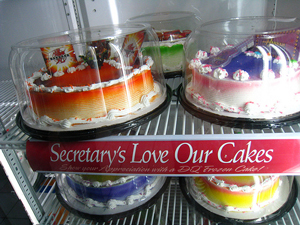Apostrophes

Source: Dairy Queen spelling mistake, RosiTulips, Flickr
O, Apostrophe! What is your lure? Why do some, like this bakery’s sign maker, insert you in unnecessary places? If more than one secretary loves these cakes, wouldn’t the simple plural, “secretaries,” do?
Other people add unnecessary apostrophes to proper names as in, “The Simpson’s grounded Homer.” In this example, the apostrophe after the iconic surname “Simpson” is not needed. When making a name plural, you don’t need an apostrophe before the s. Another redundant and incorrect use of apostrophes is to add them to possessive pronouns, as in ours’ and whose’.
Apostrophes already have plenty of legitimate punctuation tasks. Writers use them to take the place of missing letters in contractions. Apostrophes also indicate more than one letter of the alphabet, as in “How many A’s did you get?” They are the heavy lifters for showing possession too, as in barber’s shears. Watch this video clip, as a barber explains singular and plural possession.
Some words in the sentences below have unnecessary apostrophes. Other words need apostrophes because they’re contractions, singular possessives (‘s), or plural possessives (s’). In the activity below, read each sentence and decide which choice corrects the sentence. (Note: This activity is adapted from text at PBworks.com.)

Quotation Marks
Quotation marks come in pairs, and it’s smart to use the pair when the ideas are not your own.
In the U.S., commas and periods go inside the quotation marks. Using quotation marks with other punctuation might seem confusing, but the rules are actually pretty simple.
- Use quotation marks to set off a speaker’s exact words.
- When you proofread, make sure that you see a pair of quotation marks. The beginning of the quoted material should be marked and so should the end.
- Capitalize the first letter of a direct quote when the quoted material is a complete sentence.
- Do not capitalize the first letter when the quoted material is a fragment or only a piece of the original material’s complete sentence.
- If a direct quotation is interrupted mid-sentence, do not capitalize the second part of the quotation.
To proof your paper effectively, use a colored marker and mark all the quotation marks that you see. Make sure you have followed the rules above for using quotation marks correctly. Read your paper again to make sure that you have not left out any needed quotation marks.
In the exercise below, read the sentences, and decide whether the quotation marks are used correctly. Select your answer from the pull-down menu.
